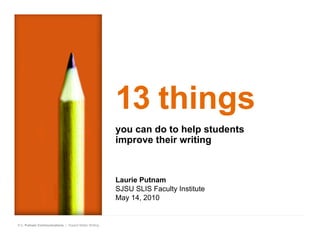More Related Content Similar to 13 Things You Can Do to Help Students Improve Their Writing (20) 1. 13 things
you can do to help students
improve their writing
A QUICK WALK
Laurie Putnam
along the path to
SJSU SLIS Faculty Institute
professional publishing
May 14, 2010
© L. Putnam Communications | Toward Better Writing
2. 1 Don’t expect
miracles.
© L. Putnam Communications | Toward Better Writing
3. 2 Do expect
progress.
© L. Putnam Communications | Toward Better Writing
4. 3 Design clear
assignments.
■ Say what you want & imagine
students doing it.
■ Use class time.
■ Build in process.
© L. Putnam Communications | Toward Better Writing
5. 4
Set checkpoints.
■ Request thesis & outline early.
■ Help struggling students early.
© L. Putnam Communications | Toward Better Writing
6. 5 Try group work
or peer reviews.
■ Let students help one another.
■ Provide guiding questions.
© L. Putnam Communications | Toward Better Writing
7. 6 Know what’s
important to you.
© L. Putnam Communications | Toward Better Writing
8. Know what’s
important to you
Classic criteria
Content; substance
Research
■
Ideas and analysis
■
Writing quality; expression of ideas
Organization
■
Style
■
Mechanics
■
© L. Putnam Communications | Toward Better Writing
9. 7
3. Set expectations.
© L. Putnam Communications | Toward Better Writing
10. Set expectations
Sample guidelines
Assignment: Does paper fully address requirements?
Substance
■ Research: Are appropriate sources used & incorporated?
■ Content: Are author’s ideas and analyses well developed?
Writing quality
■ Organization: Is content clearly & logically organized?
■ Style: Is voice clear, strong, & pleasing to read?
■ Mechanics: Are grammar, punctuation, & spelling correct?
© L. Putnam Communications | Toward Better Writing
11. 8 Try using an
evaluation tool.
© L. Putnam Communications | Toward Better Writing
12. Try using an
evaluation tool LIBR 200 Term Paper Checklist
• Includes paper title, your name, course number and section, and date
Title Page
• Brief but comprehensive summary of the paper’s contents, not
Abstract exceeding 120 words (See APA 1.07)
• Topic I.D.
Intro • Why it’s important
• Core overarching/synthetic question assembled from all the
secondary scholarship
• The overarching answer/thesis interpreted from all the secondary
scholarship
• Naming the sub-topics identified (the sub-headings)
• A new original question that deserves future treatment by the field
(based on current gaps or furthering hot topics).
• The best papers will offer a speculative answer to the new question
• A brief (one or two paragraphs only) synthetic survey of the most
Lit Review recent and relevant scholarly writing on your topic.
• Note: this is not just a “revision” of your earlier lit review paper
• A brief section (about 1 paragraph) noting questions and topics that
Gaps you find would strengthen this body of literature or note any gaps you
perceive in the current scholarly literature
• A transition sentence or two that reiterates what specific topic your
paper will address and how it contributes to the literature
• Explain the searching processes and search syntax you used to
Methodology search, discover, and gather sources used in paper
(According to APA, lit review
comes before methodology)
• Present your findings. This should consist of grouping your secondary
Body and sources into categories that makes sense to you. Approach this
literature from the point of view of your own original and overarching
Findings question.
• Take care to use APA format for your parenthetical references
• Summarize by restating the core overarching/synthetic question and
Conclusion thesis assembled from all the current secondary scholarship you
covered
• Restate your own central/controlling question and the conclusions
that your research supports. This is also an excellent point to also
offer or nominate new or different questions you feel are important but
have not yet been asked thus far by the literature on your topic.
© L. Putnam Communications | Toward Better Writing • Reference list should include at least 20 items (mostly peer-reviewed)
References and be presented in the style dictated in the APA Publication Manual.
13. Try using an evaluation tool
Criteria Points Comments
Content (50%) 3 6 9 12 15
Organization 1 2 3 4 5
Style 1 2 3 4 5
Mechanics 1 2 3 4 5
Total points &
general comments
© L. Putnam Communications | Toward Better Writing
14. Try using an
evaluation tool
Sample rubrics
■ http://tinyurl.com/Drake-Rubric
■ http://tinyurl.com/MarsHill-Rubric
■ http://tinyurl.com/UC-Harvard-Rubric
A QUICK WALK
■ http://tinyurl.com/UColorado-Rubric
http://tinyurl.com/APUS-Rubric
■
along the path to
professional publishing
© L. Putnam Communications | Toward Better Writing
15. 9 Read each
paper twice.
■ Skim through once.
■ Then read carefully.
© L. Putnam Communications | Toward Better Writing
16. 10 Give summary
comments.
■ Restate paper’s main point.
■ Discuss strengths.
■ Discuss weaknesses.
© L. Putnam Communications | Toward Better Writing
17. 11 Encourage.
Question.
Consider.
© L. Putnam Communications | Toward Better Writing
18. 12 Review others as
you would have
others review you.
■ Be kind.
■ Be clear.
■ Stay focused.
© L. Putnam Communications | Toward Better Writing
19. 13 Remember
the goals.
■ Let students know where they stand.
■ Help students improve their work.
© L. Putnam Communications | Toward Better Writing

